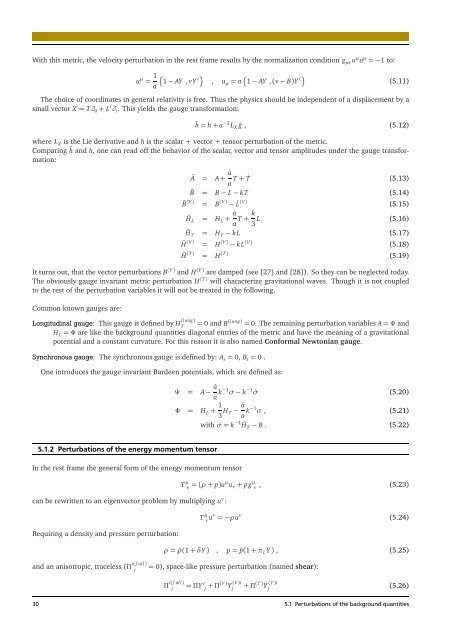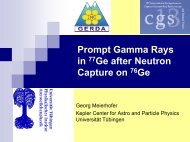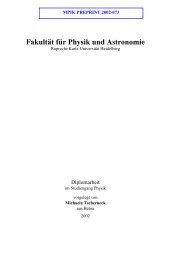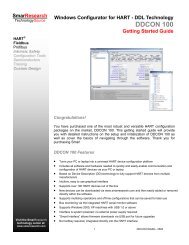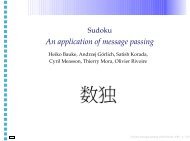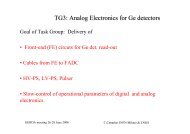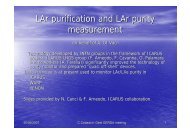Master Thesis
Master Thesis
Master Thesis
You also want an ePaper? Increase the reach of your titles
YUMPU automatically turns print PDFs into web optimized ePapers that Google loves.
With this metric, the velocity perturbation in the rest frame results by the normalization condition g µνu µ u µ =−1 to:<br />
u µ = 1�<br />
i<br />
1−AY , vY<br />
a<br />
�<br />
, u µ=a � 1−AY ,(v−B)Y i�<br />
(5.11)<br />
The choice of coordinates in general relativity is free. Thus the physics should be independent of a displacement by a<br />
small vector X= T∂ 0+ L i ∂ i. This yields the gauge transformation:<br />
˜ h=h+ a −2 LX ¯g , (5.12)<br />
where L X is the Lie derivative and h is the scalar + vector + tensor perturbation of the metric.<br />
Comparing ˜ h and h, one can read off the behavior of the scalar, vector and tensor amplitudes under the gauge transformation:<br />
à = A+ ˙a<br />
a T+ ˙T (5.13)<br />
˜B = B−˙L−kT (5.14)<br />
˜B (V) = B (V) − ˙L (V)<br />
(5.15)<br />
˜H L = HL+ ˙a k<br />
T+ L<br />
a 3<br />
(5.16)<br />
˜H T = HT− kL (5.17)<br />
˜H (V) = H (V) − kL (V)<br />
˜H (T) = H (T)<br />
(5.18)<br />
(5.19)<br />
It turns out, that the vector perturbations B (V) and H (V) are damped (see [27] and [28]). So they can be neglected today.<br />
The obviously gauge invariant metric perturbation H (T) will characterize gravitational waves. Though it is not coupled<br />
to the rest of the perturbation variables it will not be treated in the following.<br />
Common known gauges are:<br />
Longitudinalgauge: This gauge is defined by H (long)<br />
T = 0 and B (long) = 0. The remaining perturbation variables A=Ψand<br />
HL=Φ are like the background quantities diagonal entries of the metric and have the meaning of a gravitational<br />
potential and a constant curvature. For this reason it is also named Conformal Newtonian gauge.<br />
Synchronous gauge: The synchronous gauge is defined by: A s= 0, B s= 0 .<br />
One introduces the gauge invariant Bardeen potentials, which are defined as:<br />
5.1.2 Perturbationsof theenergymomentum tensor<br />
In the rest frame the general form of the energy momentum tensor<br />
can be rewritten to an eigenvector problem by multiplying u ν :<br />
Requiring a density and pressure perturbation:<br />
Ψ = A− ˙a<br />
a k−1 σ− k −1 ˙σ (5.20)<br />
Φ = H L+ 1<br />
3 H T− ˙a<br />
a k−1 σ , (5.21)<br />
withσ=k −1 ˙H T− B . (5.22)<br />
T µ<br />
ν =(ρ+p)uµ uν+ pg µ<br />
ν , (5.23)<br />
T µ<br />
ν uν =−ρu ν<br />
(5.24)<br />
ρ= ¯ρ(1+δY) , p=¯p(1+π LY) , (5.25)<br />
i(f ull)<br />
and an anisotropic, traceless (Π j = 0), space-like pressure perturbation (named shear):<br />
i(f ull)<br />
Π j =ΠY i<br />
j +Π(V) Y (V)i<br />
j<br />
+Π(T) Y (T)i<br />
j<br />
(5.26)<br />
30 5.1 Perturbations of thebackground quantities


